Aurizon Holdings Limited is a freight rail transport company in Australia, formerly named QR National Limited and branded QR National. In 2015, it was the world's largest rail transporter of coal from mine to port. Formerly a Queensland Government-owned company, it was privatised and floated on the Australian Securities Exchange (ASX) in November 2010. The company was originally established in 2004–05 when the coal, bulk, and container transport divisions from Queensland Rail were brought under one banner as QR National.

Mining in Australia has long been a significant primary sector industry and contributor to the Australian economy by providing export income, royalty payments and employment. Historically, mining booms have also encouraged population growth via immigration to Australia, particularly the gold rushes of the 1850s. Many different ores, gems and minerals have been mined in the past and a wide variety are still mined throughout the country.

The Swanbank Power Stations are located in Swanbank within South East Queensland, Australia. The original power station was coal fired, but the site has since moved to gas. By 2007 the site had consisted of the highly efficient 385 megawatts (516,000 hp) gas-fired Swanbank E Power Station and the smaller 28 megawatts (38,000 hp) gas-fired Swanbank C Power Station. Swanbank E was written off by the Queensland Audit Office as having no value, as it is uneconomical to run in 2021.

The Bowen Basin contains the largest coal reserves in Australia. This major coal-producing region contains one of the world's largest deposits of bituminous coal. The Basin contains much of the known Permian coal resources in Queensland including virtually all of the known mineable prime coking coal. It was named for the Bowen River, itself named after Queensland's first Governor, Sir George Bowen.
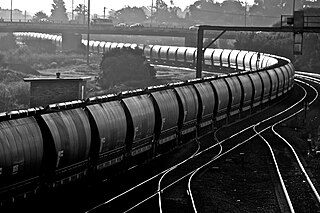
The Hunter Valley Coal Chain (HVCC) is the chain of coal delivery in New South Wales, Australia from coal mines in the Hunter Region to the Port of Newcastle and domestic coal-fired power stations in the Hunter Valley. The HVCC essentially follows the path of the Hunter River travelling south-east from the mining areas in the Hunter Valley to Newcastle.
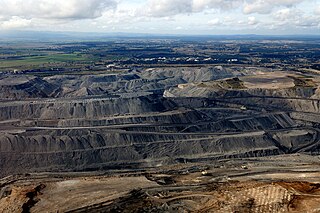
Coal is mined in every state of Australia. The largest black coal resources occur in Queensland and New South Wales. About 70% of coal mined in Australia is exported, mostly to eastern Asia, and of the balance most is used in electricity generation. In 2019-20 Australia exported 390 Mt of coal and was the world's largest exporter of metallurgical coal and second largest exporter of thermal coal.
The New Acland Mine is located adjacent to Acland township, about 10 km north of Oakey on the Darling Downs in Queensland, Australia. Geologically it is part of the Wallon Coal Measures and contains more than 500 million tonnes of coal that is removed by the open cut method. The mine is owned and operated by New Hope Coal. As of Monday, September 2, 2019, the mine has become mothballed due to extension applications being denied. A stockpile will require trains to run for a little while longer, roughly twelve months.
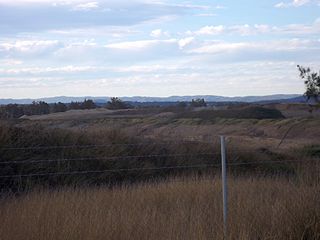
The Jeebropilly Mine is an open pit coal mine in the Moreton Basin near Amberley in South East Queensland. The mine is owned by New Hope Coal.
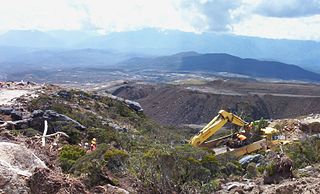
Stockton Mine, on the Stockton Coal Field, is New Zealand's largest opencast mining operation. The entrance to the mine is at the former settlement of Stockton.

Acland is a rural town and locality in the Toowoomba Region, Queensland, Australia. In the 2016 census the locality of Acland had a population of 32 people.

Macarthur Coal was a mining company based in Queensland, Australia, which was incorporated in October 1995. The company was founded by Ken Talbot, who was a former chief executive officer.
The Box Flat Mine or Box Flat Colliery was located at Swanbank in Ipswich, Queensland, Australia. The mine opened in 1969 and operated until its closure on 30 June 1987. Its coal was mined for the operation of the Swanbank Power Station.
The Queensland Pioneer Steam Railway is located near Ipswich, Queensland, Australia and runs through the former West Moreton pioneering coal fields. It was first opened in 1881 by colliery proprietor and politician Lewis Thomas (1832-1913) as a tramway to his coal mines.
÷Some of the more notable coal companies in Australia are the following:
The Gregory Coal Mine is an open-cut coal mine located at Crinum, 60 km north east of Emerald in Central Queensland, Australia. The mine has coal reserves amounting to 159 million tonnes of coking coal, one of the largest coal reserves in Australia and the world. The Bowen Basin mine has an annual production capacity of 5 million tonnes of coal. Operations at the Gregory mine started in 1979. Coal from the mine is exported to the Port of Gladstone via the Blackwater railway system.
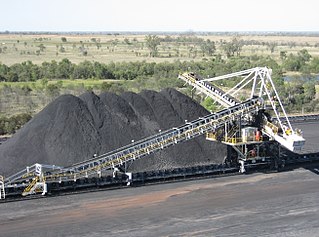
The Kestrel Coal Mine is an underground coal mine located in the Bowen Basin at Crinum, 51 km northeast of Emerald in Central Queensland, Australia. The mine has coal reserves amounting to 158 million tonnes of coking coal, one of the largest coal reserves in Asia and the world. The mine has an annual production capacity of 4 million tonnes of coal. Both hard/semi hard coking coal and thermal coal is mined.
The Oaky Creek Coal Mine is a coal mine located 17 kilometres east-southeast of Tieri in the Bowen Basin in Central Queensland, Australia. The mine has coal reserves amounting to 288 million tonnes of coking coal, one of the largest coal reserves in Asia and the world. The mine has an annual production capacity of 11 million tonnes of coal. Oaky Creek is one of Australia's highest producing coal mines over a period of several years. It was opened in 1983.

The Saraji Coal Mine is a coal mine located near Dysart in the Central Queensland region of Australia. The mine has coal reserves amounting to 648 million tonnes of coking coal, one of the largest coal reserves in Asia and the world. The mine has an annual production capacity of 10 million tonnes of coal. It is located in the Bowen Basin, an area with significant coal deposits and numerous mines. It is owned by the BHP Mitsubishi Alliance (BMA).
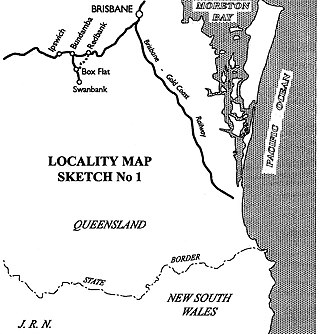
The Redbank-Bundamba Loop Line was a branch line off the Main Line railway near Brisbane, Queensland, Australia. It was built to convey coal from the Bundamba and Redbank areas of the Ipswich coalfields. The Redbank-Bundamba Loop Line ran generally south-west from Redbank station to a point near Bundamba Creek called Box Flat Junction and from that point generally north along Bundamba Creek to Bundamba station.

The Bowen Basin Coalfields contains the largest coal reserves in Australia. This major coal-producing region contains one of the world's largest deposits of bituminous coal. The Basin contains much of the known Permian coal resources in Queensland including virtually all of the known mineable prime coking coal. It was named for the Bowen River, itself named after Queensland's first Governor, Sir George Bowen.













